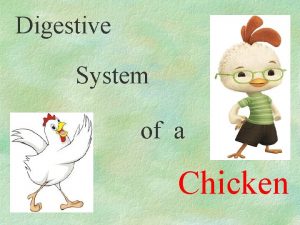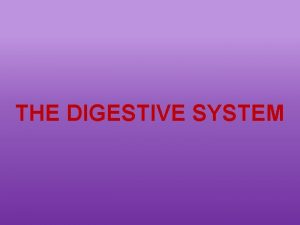The Digestive System The Digestive System The digestive













- Slides: 13

The Digestive System

The Digestive System The digestive system has Mouth three main functions: Esophagus 1. It breaks down food into particles that the body can use. 2. It absorbs nutrients into the blood. 3. It eliminates waste from the body.

The Digestive System Digestion can happen in two Mouth ways: Esophagus 1. Mechanical digestion: foods are physically broken down into smaller parts (like by teeth grinding, crushing, and breaking apart your food).

The Digestive System Digestion can happen in two ways: Mouth 2. Chemical digestion: Chemicals break Esophagus foods into smaller, simpler substances. Saliva moistens food to make it easier to swallow and also contains enzymes that begins to break down food. Enzymes are proteins that speeds up a chemical reaction.

The Digestive System • In the mouth, your teeth break down food into smaller pieces (mechanical digestion). After food is swallowed, it passes the epiglottis, a flap of tissue that covers the opening of the trachea to keep food out. Mouth Esophagus

The Digestive System • The food then moves to the esophagus. The esophagus is a smooth muscular tube that connect the mouth to the stomach and pushes food down Mouth Esophagus

The Digestive System • Most digestion happens Mouth in the stomach: • Mechanical digestion Esophagus occurs when the stomach muscles churn the food. • Chemical digestion happens when stomach acid breaks down food. Stomach

The Digestive System • Food remains in the stomach for several hours. The stomach digests the food into a liquid. This liquid enters the small intestine, a long muscular tube where the body absorbs nutrients. Mouth Esophagus Liver Gallbladder Stomach Pancreas Small intestine Large intestine Rectum

The Digestive System Mouth • The pancreas is a gland that releases Esophagus digestive enzymes and other chemicals into Liver the small intestine. Gallbladder Stomach Pancreas Small intestine Large intestine Rectum

The Digestive System • The liver is an organ that makes bile, a liquid that helps break down fat. • Bile is temporarily stored in the gall bladder until it is needed by the small intestine. Mouth Esophagus Liver Gallbladder Stomach Pancreas Small intestine Large intestine Rectum

The Digestive System Once food is digested, nutrients are absorbed through the wall of the small intestine. The folds of the small intestine called villi contain capillaries through which nutrients enters the bloodstream. Mouth Esophagus Liver Gallbladder Stomach Pancreas Small intestine Large intestine Rectum

The Digestive System The blood transports Mouth nutrients to all the Esophagus cells of the body. Any undigested material in the small intestine is Liver moved by peristalsis Small intestine (contractions) into the Large intestine large intestine. Gallbladder Stomach Pancreas Rectum

The Digestive System The large intestine Mouth belongs to the Esophagus digestive and the excretory systems. It’s role is to absorb Liver water and compact the Small intestine solid waste from the Large undigested material. intestine Gallbladder Stomach Pancreas Rectum
 Site:slidetodoc.com
Site:slidetodoc.com Nervous system and digestive system
Nervous system and digestive system Hình ảnh bộ gõ cơ thể búng tay
Hình ảnh bộ gõ cơ thể búng tay Frameset trong html5
Frameset trong html5 Bổ thể
Bổ thể Tỉ lệ cơ thể trẻ em
Tỉ lệ cơ thể trẻ em Gấu đi như thế nào
Gấu đi như thế nào Thang điểm glasgow
Thang điểm glasgow Bài hát chúa yêu trần thế alleluia
Bài hát chúa yêu trần thế alleluia Kể tên các môn thể thao
Kể tên các môn thể thao Thế nào là hệ số cao nhất
Thế nào là hệ số cao nhất Các châu lục và đại dương trên thế giới
Các châu lục và đại dương trên thế giới Công thức tính độ biến thiên đông lượng
Công thức tính độ biến thiên đông lượng Trời xanh đây là của chúng ta thể thơ
Trời xanh đây là của chúng ta thể thơ

























